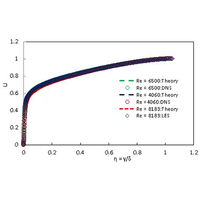Approximate derivation of the power law for the mean streamwise velocity in a turbulent boundary layer under zero-pressure gradient
IF 2.5
3区 物理与天体物理
Q2 PHYSICS, FLUIDS & PLASMAS
引用次数: 0
Abstract
Distribution of the mean streamwise velocity in a turbulent boundary layer over a flat plate can be represented by the equation , as was widely used in the past; and are the normalized velocity and the wall-normal distance, respectively. However, this -power law is an empirical one. By incorporating either the Reynolds shear stress model of Wei et al. [J. Fluid Mech. 969, A3 (2023)], which is in terms of and the (normalized) wall-normal velocity (), or a similar one in the boundary layer equations, it is found that and are related as in the outer region of a flat plate boundary layer; is the flow shape parameter. Along with the distribution of the wall-normal velocity () of Wei et al., the -power law for is obtained by equating the derivative (with respect to ) of with that of . Thus, this empirical power law seems to have a reasonable theoretical basis embedded in it.

零压力梯度下湍流边界层平均流向速度幂律的近似推导
平板上湍流边界层的平均流向速度分布可用方程 U∼η1/n 表示,这在过去被广泛使用;U 和 η 分别是归一化速度和壁面法线距离。然而,这个 1/n 次幂定律是一个经验定律。通过将 Wei 等人的雷诺剪应力模型[J. Fluid Mech. 969, A3 (2023)](以 U 和(归一化)壁面法向速度 (V) 表示)或类似的模型纳入边界层方程,可以发现在平板边界层的外部区域,U 和 V 的关系为 U(H+1)∼V(H-1);H 是流动形状参数。根据 Wei 等人的壁面法向速度(Vw)分布,将 V 的导数(相对于 η)等同于 Vw 的导数,即可得到 U 的 1/n 次幂律。因此,这一经验幂律似乎具有合理的理论基础。
本文章由计算机程序翻译,如有差异,请以英文原文为准。
求助全文
约1分钟内获得全文
求助全文
来源期刊

Physical Review Fluids
Chemical Engineering-Fluid Flow and Transfer Processes
CiteScore
5.10
自引率
11.10%
发文量
488
期刊介绍:
Physical Review Fluids is APS’s newest online-only journal dedicated to publishing innovative research that will significantly advance the fundamental understanding of fluid dynamics. Physical Review Fluids expands the scope of the APS journals to include additional areas of fluid dynamics research, complements the existing Physical Review collection, and maintains the same quality and reputation that authors and subscribers expect from APS. The journal is published with the endorsement of the APS Division of Fluid Dynamics.
 求助内容:
求助内容: 应助结果提醒方式:
应助结果提醒方式:


